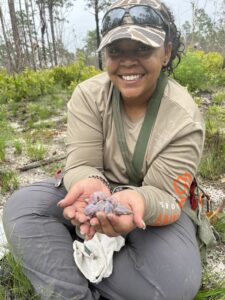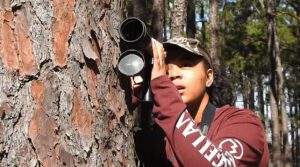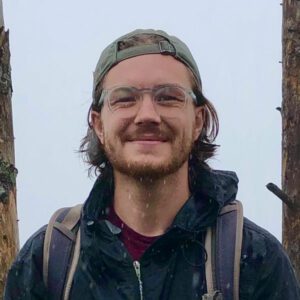Diversity, Inclusion, and Woodpeckers: An Interview with Governor’s Conservation Award Recipient and Avian Ecologist Lauren D. Pharr

What do diversity, inclusion, and woodpeckers have in common?
The answer: Lauren D. Pharr.
Wildlife conservation is a monumental undertaking incorporating individuals from a vast range of scientific, political, and community organizing specializations – and all with equally vast viewpoints and interests. But one of the largest callings of all those with a heart for wildlife is this: to be a voice for the voiceless.
This February, we are celebrating “For the Love of Birds“, calling attention to the avian wildlife species in our state – particularly Red-cockaded woodpeckers.
Many bird species are facing increasing threats at the hand of development, climate change, habitat degradation, fragmentation, and pollution. One such species is the Red-cockaded woodpecker – a bird that has garnered much support across the state due to the perils it continues to face. There is hope for Red-cockaded woodpeckers… nevertheless, they are not out of the woods yet.
But thanks to people like Lauren D. Pharr, NCWF Governor’s Conservation Achievement Award recipient, this species is not without allies.
 Avian ecologist and Ph.D student Lauren D. Pharr is one such individual, and has been selected as the recipient of NCWF’s Young Conservationist of the Year award. Lauren has an M.S. in Fisheries, Wildlife, and Conservation Biology from North Carolina State University and is currently pursuing her Ph.D. With a research focus in avian ecology and conservation, she is currently investigating the impact of climate change on the reproductive success of Red-cockaded woodpeckers.
Avian ecologist and Ph.D student Lauren D. Pharr is one such individual, and has been selected as the recipient of NCWF’s Young Conservationist of the Year award. Lauren has an M.S. in Fisheries, Wildlife, and Conservation Biology from North Carolina State University and is currently pursuing her Ph.D. With a research focus in avian ecology and conservation, she is currently investigating the impact of climate change on the reproductive success of Red-cockaded woodpeckers.
Lauren is also Co-Founder of Field Inclusive, a nonprofit organization that strives to provide access to the natural environment by addressing social field safety issues related to justice, equity, diversity, and inclusion.
We connected with Lauren to ask a few questions about the impact she is having for wildlife and for a mission of inclusivity in the field of conservation science.
To read more about Red-cockaded woodpeckers, check out our blog post: For the Love of Birds: Seven Birds from North Carolina’s list of Species of Greatest Conservation Need.
-
Q. Why have you chosen to specialize in Red-cockaded woodpeckers?
Lauren: I wholeheartedly credit my advisor Dr. Caren Cooper for introducing me to the Red-cockaded woodpecker world. For my Ph.D. I had stated that I wanted to carry out something intensive for my field work, and boy, was I not disappointed. I have only been studying Red-cockaded woodpeckers for almost 3 years, but it feels like a lifetime of nothing but pure satisfaction. Learning about the history of this endangered species, and its conservation success story, the interesting question about impacts on their reproductive success came about when realizing that this species depends on specific conservation and management to continue to thrive, which it has been doing over the past few years. Now, it’s all about continuing to understand impacts of a changing world and in this specific case, climate change, so that we can make sure this species is protected and around for years to come. Aside from my own research, I also get to help with the management of this species right here in North Carolina. Through the Red-cockaded woodpecker I have become intrigued with the longleaf pine ecosystem (where this species lives), endangered avian species, and avian ecology and conservation as a whole.
-
Q. What is Field Inclusive and why is it important? What does it accomplish?
Lauren: Field Inclusive was started by two Black women and ornithologists, Murry Burgess and myself, who recognized inequities surrounding field work and social field safety. Social field safety involves at-risk individuals, which include minority identities of the following: race/ethnicity, sexual orientation, disability, gender identity, and religion. When individuals from these backgrounds enter unfamiliar communities in the course of field work, they may be placed in an uncomfortable and potentially unsafe, “othered” position, and prejudice may manifest against them. Along with amplifying and supporting marginalized and historically excluded field researchers and continuing to discuss the importance of this topic with institutions and various organizations, Field Inclusive also seeks to target those from marginalized backgrounds when it comes to opportunities to gain field work experiences which we hope will in turn cater to the environmental sciences becoming more diverse in the future.
-
Q. How did you become involved and interested in co-founding Field Inclusive?
Lauren: Having heard from others about their experiences, as well as Murry and I continuing to conduct field work outdoors as a part of our PhD program requirements at North Carolina State University and witnessing and experiencing some of these instances first hand, it was then that we knew something had to be done, and that social field safety needs to be raised to the same level as the typical physical field safety — such as identifying poisonous plants and venomous animals, or watching out for stump holes — that is talked about in many institutions’ field safety seminars.
-
Q. Why do you feel diversity and inclusion is important in the field of conservation science?
 Lauren: This field has not always been Black and white. And people wonder why that is. But throughout all of this, there was one thing that I came to realize the further I got in my studies. There are not a lot of people who look like me, in the conservation field. Even now, I am always finding myself representing the minority amongst my colleagues in various spaces: academic, environmental organizations, committees dedicated to conservation. Every other day I am reminded of this, but every other day I am also reminded that I am paving the way for others like me in this field. I hope to be the one who contributed to creating a safe and inclusive space for them at the table. I want to continue to inspire, and allow others like me to see that their diverse backgrounds and creativity belong in these spaces. I plan to continue to advocate in STEM and actively encourage the participation of People of Color. I am continuously driven through my experiences to be a STEM leader that uses the human experience, including my own, to build an inclusive community for future generations to come, and I will continue to stress to others to try and do the same.
Lauren: This field has not always been Black and white. And people wonder why that is. But throughout all of this, there was one thing that I came to realize the further I got in my studies. There are not a lot of people who look like me, in the conservation field. Even now, I am always finding myself representing the minority amongst my colleagues in various spaces: academic, environmental organizations, committees dedicated to conservation. Every other day I am reminded of this, but every other day I am also reminded that I am paving the way for others like me in this field. I hope to be the one who contributed to creating a safe and inclusive space for them at the table. I want to continue to inspire, and allow others like me to see that their diverse backgrounds and creativity belong in these spaces. I plan to continue to advocate in STEM and actively encourage the participation of People of Color. I am continuously driven through my experiences to be a STEM leader that uses the human experience, including my own, to build an inclusive community for future generations to come, and I will continue to stress to others to try and do the same.
-
Q. Do you have any words of encouragement for young people interested in pursuing the type of work you are doing?
Lauren: I always stress the fact that it is okay to change your mind about what you want to do for the rest of your life, especially when it comes to your career. Switching from wanting to be a veterinarian to a pharmacist to a wildlife biologist, I have been at the point in life where it feels like you’re making this big decision that you can’t change once you decide. But that is not the case. Sure it’s scary, but follow your passion. I know that sounds cliche, but it is the truth. Also, don’t ever let other people’s questions or confusion about your decision, or your career path, influence your decision. Do what you love, and love what you do!
-
Q. What are some steps that those in the field of conservation/wildlife research can take to foster diversity and inclusion?
Lauren: Simply put, institutions and organizations need to become more aware of the history of why certain groups do not feel welcome in the outdoors, and the work needs to be put in in order for us to see any changes in the near future. White privilege needs to be recognized. Marginalized and historically excluded biologists and researchers need to be heard. Once we can begin to address all this, then change can gradually come. If you are open and willing to become educated about these things, then you can start becoming an ally and learn how to promote a more inclusive and safe space for your minority researchers and workers.
As far as resources to get the conversation started, my nonprofit Field Inclusive hosted our first #FieldInclusiveWeek in January where we invited speakers to speak on various topics related to field safety concerns. Webinar recordings, speaker PDFs, and other resources can be found on our website. There is also a great academic paper, “Safe fieldwork strategies for at-risk individuals, their supervisors and institutions“ by Demery et al. which talks about the importance of various social field safety issues. Other resources we have include how to construct an effective Code of Conduct, as well as tips to attract diverse applicants.
To read more about Red-cockaded woodpeckers, check out our blog post: For the Love of Birds: Seven Birds from North Carolina’s list of Species of Greatest Conservation Need.

- Written by Bates Whitaker, NCWF Communications & Marketing Manager


